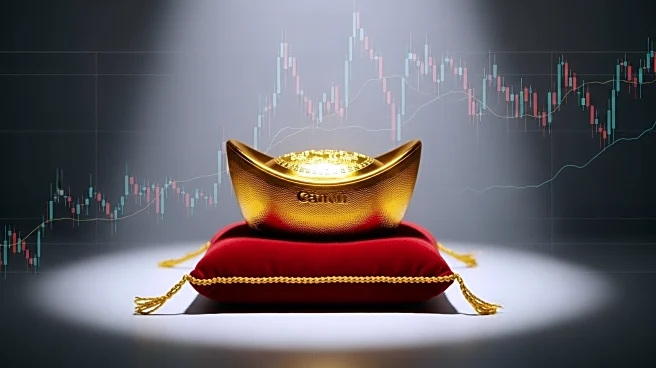What is the story about?
What's Happening?
Gold prices have reached an unprecedented high, surpassing the $3,900-per-ounce mark as investors seek refuge in safe-haven assets amidst the ongoing U.S. government shutdown and broader economic uncertainties. The surge in gold prices is also influenced by expectations of further interest rate cuts by the Federal Reserve. Spot gold increased by 1.4% to $3,940.04 per ounce, with U.S. gold futures for December delivery climbing to $3,964.50. The current rally in gold is driven by strong central bank purchases, increased demand for gold-backed exchange-traded funds, and a weaker dollar. Analysts suggest that the rally is characterized by long-term investors rather than speculative buyers, indicating potential buying opportunities on price dips.
Why It's Important?
The rise in gold prices highlights the growing economic concerns and the impact of the U.S. government shutdown on financial markets. As a traditional safe-haven asset, gold's appeal increases during periods of economic instability and low-interest rates. The Federal Reserve's anticipated rate cuts further enhance gold's attractiveness, as non-yielding assets like gold perform well in such environments. This development could have significant implications for investors seeking to hedge against economic volatility and for central banks looking to diversify their reserves. The situation underscores the broader economic challenges facing the U.S., including labor market weaknesses and geopolitical tensions.
What's Next?
If the U.S. government shutdown persists, it could lead to mass layoffs of federal workers, as indicated by a senior White House official. This scenario may further exacerbate economic uncertainties, potentially driving more investors towards safe-haven assets like gold. Additionally, the Federal Reserve's upcoming meetings and decisions on interest rate cuts will be closely monitored by investors. A continued rally in gold prices could influence investment strategies and central bank policies globally, as stakeholders assess the long-term economic outlook.
AI Generated Content
Do you find this article useful?













